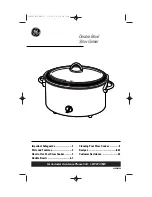
TIPS FOR SUCCESSFUL OPERATION
As you become familiar with your new small appliance, we want to share
a few suggestions for adapting your traditional recipes for the slow cooker.
You may want to begin by referring to slow cooker cookbooks for recipes
similar to those you want to adapt. They will serve as a guide for cooking
times and temperatures. Refer to our handy “Suggested Slow Cooker
Settings” in the Quick Start Guide.
Why Moist Heat?
In general, slow cooking is a moist heat method of cooking. Steam
accumulates under the lid during cooking, which naturally adds more
moisture during the cooking process. This type of cooking is especially
suitable for foods that benefit from simmering in liquids over several hours to
tenderize and/or develop flavors.
Tips:
•
When using traditional recipes for the slow cooker, reduce the liquid by
about one-half, unless making soup or long grain rice.
•
If you lift the lid at the end of the cooking time and discover there is too
much liquid that has accumulated during cooking, remove the lid. Set
the slow cooker on high for about 30 minutes and some of the liquid will
simmer away.
•
Cut vegetables into approximately one-inch pieces so that they are bite-
sized and cook evenly.
•
Reserve tender vegetables (such as broccoli and asparagus), pasta, and
quick cooking rice, and add in the final 30 minutes of cooking time.
•
Dairy products tend to break down when using a long cooking process.
So, wait and stir them in about 30 minutes before the end of the
cooking time.
•
Seafood should be added during the last hour to avoid overcooking.
•
Brown meats, including ground meats, before slow cooking for added
flavor. And, slice larger cuts of meat (such as pot roast) into pieces
before placing in slow cooker.
•
When slow cooking a roast, add approximately one cup of liquid (i.e.,
beef or vegetable broth) to the ceramic crock for a 2½ to 3 pound roast.
10
Summary of Contents for Model HE400SC
Page 1: ...4 Qt Digital Slow Cooker USER GUIDE Model HE400SC...
Page 20: ...2011...






































